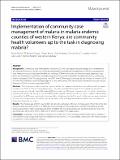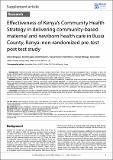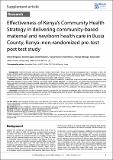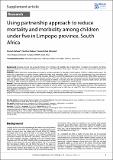Implementation of Community Case Management of Malaria in Malaria Endemic Counties of Western Kenya: Are Community Health Volunteers up to the Task in Diagnosing Malaria?
View/
Publication Date
2022-03-05Type
Article, Journalviews
downloads
Metadata
Show full item recordCitation
Marita, E., Langat, B., Kinyari, T. et al. Implementation of community case management of malaria in malaria endemic counties of western Kenya: are community health volunteers up to the task in diagnosing malaria?. Malar J 21, 73 (2022). https://doi.org/10.1186/s12936-022-04094-w
Abstract/
Background Community case management of malaria (CCMm) is an equity-focused strategy that complements and extends the reach of health services by providing timely and effective management of malaria to populations with limited access to facility-based healthcare. In Kenya, CCMm involves the use of malaria rapid diagnostic tests (RDT) and treatment of confirmed uncomplicated malaria cases with artemether lumefantrine (AL) by community health volunteers (CHVs). The test positivity rate (TPR) from CCMm reports collected by the Ministry of Health in 2018 was two-fold compared to facility-based reports for the same period. This necessitated the need to evaluate the performance of CHVs in conducting malaria RDTs. Methods The study was conducted in four counties within the malaria-endemic lake zone in Kenya with a malaria prevalence in 2018 of 27%; the national prevalence of malaria was 8%. Multi-stage cluster sampling and random selection were used. Results from 200 malaria RDTs performed by CHVs were compared with test results obtained by experienced medical laboratory technicians (MLT) performing the same test under the same conditions. Blood slides prepared by the MLTs were examined microscopically as a back-up check of the results. A Kappa score was calculated to assess level of agreement. Sensitivity, specificity, and positive and negative predictive values were calculated to determine diagnostic accuracy. Results The median age of CHVs was 46 (IQR: 38, 52) with a range (26–73) years. Females were 72% of the CHVs. Test positivity rates were 42% and 41% for MLTs and CHVs respectively. The kappa score was 0.89, indicating an almost perfect agreement in RDT results between CHVs and MLTs. The overall sensitivity and specificity between the CHVs and MLTs were 95.0% (95% CI 87.7, 98.6) and 94.0% (95% CI 88.0, 97.5), respectively. Conclusion Engaging CHVs to diagnose malaria cases under the CCMm strategy yielded results which compared well with the results of qualified experienced laboratory personnel. CHVs can reliably continue to offer malaria diagnosis using RDTs in the community setting.
Subject/
Community case management of malaria (CCMm); Rapid diagnostic tests; Lake zone; Kappa; Sensitivity; Community health committees (CHC); community health extension workers (CHEWs)
Further Details
This article is licensed under a Creative Commons Attribution 4.0 International License, which permits use, sharing, adaptation, distribution and reproduction in any medium or format, as long as you give appropriate credit to the original author(s) and the source, provide a link to the Creative Commons licence, and indicate if changes were made. The images or other third party material in this article are included in the article’s Creative Commons licence, unless indicated otherwise in a credit line to the material. If material is not included in the article’s Creative Commons licence and your intended use is not permitted by statutory regulation or exceeds the permitted use, you will need to obtain permission directly from the copyright holder. To view a copy of this licence, visit http:// creat iveco mmons. org/ licen ses/ by/4. 0/. The Creative Commons Public Domain Dedication waiver (http:// creat ivecommons. org/ publi cdoma in/ zero/1. 0/) applies to the data made available in this article, unless otherwise stated in a credit line to the data.
Publisher
BMC CentralCollections
- General - GEN [367]
Related items
Showing items related by title, author, creator and subject.
-
Effectiveness of Kenya’s Community Health Strategy in Delivering Community-based Maternal and Newborn Health Care in Busia County, Kenya:
Wangalwa, Gilbert; Cudjoe, Bennett; Wamalwa, David; Machira, Yvonne; Ofware, Peter; Ndirangu, Meshack; Ilako, Festus (Pan African Medical Journal, 12/26/2012)Background: Maternal mortality ratio and neonatal mortality rate trends in Kenya have remained unacceptably high in a decade. In 2007, the Ministry of Public Health and Sanitation adopted a community health strategy to ... -
Effectiveness of Kenya's Community Health Strategy in delivering community-based maternal and newborn health care in Busia County, Kenya: non-randomized pre-test post test study
Wangalwa, Gilbert; Cudjoe, Bennett; Wamalwa, David; Machira, Yvonne; Ofware, Peter; Ndirangu, Meshack; Ilako, Festus (Pan African Medical Journal, 12/26/2012)Background: Maternal mortality ratio and neonatal mortality rate trends in Kenya have remained unacceptably high in a decade. In 2007, the Ministry of Public Health and Sanitation adopted a community health strategy to ... -
Using Partnership Approach to Reduce Mortality and Morbidity Among Children Under Five in Limpopo Province, South Africa
Sivhaga, Kennedy; Hlabano, Boniface; Odhiambo, Penina Ochola (Pan African Medical Journal., 12/26/2012)Background: Limpopo province has among the highest child mortality and morbidity rates in South Africa. To address this problem, the African Medical and Research Foundation implemented an integrated c-IMCI and child survival ...




